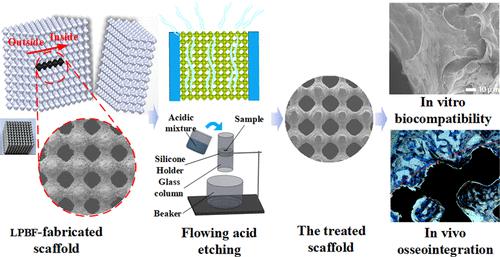当前位置:
X-MOL 学术
›
ACS Biomater. Sci. Eng.
›
论文详情
Our official English website, www.x-mol.net, welcomes your feedback! (Note: you will need to create a separate account there.)
Complete Removal of Residual Particles and Realization of Mechanical Properties to Improve Osseointegration in Additively Manufactured Ti6Al4 V Scaffolds through Flowing Acid Etching
ACS Biomaterials Science & Engineering ( IF 5.8 ) Pub Date : 2024-04-08 , DOI: 10.1021/acsbiomaterials.3c01899 Hongwei Wang 1, 2 , Yi Wan 2 , Mingzhi Yu 2 , Zhenbing Ji 2 , Geng Zhao 3 , Jinhe Dou 1 , Weidong Su 1 , Chao Liu 4
ACS Biomaterials Science & Engineering ( IF 5.8 ) Pub Date : 2024-04-08 , DOI: 10.1021/acsbiomaterials.3c01899 Hongwei Wang 1, 2 , Yi Wan 2 , Mingzhi Yu 2 , Zhenbing Ji 2 , Geng Zhao 3 , Jinhe Dou 1 , Weidong Su 1 , Chao Liu 4
Affiliation

|
Massive unmelted Ti6Al4 V (Ti64) particles presented across all surfaces of additively manufactured Ti64 scaffolds significantly impacted the designed surface topography, mechanical properties, and permeability, reducing the osseointegration of the scaffolds. In this study, the proposed flowing acid etching (FAE) method presented high efficiency in eliminating Ti64 particles and enhancing the surface modification capacity across all surfaces of Ti64 scaffolds. The Ti64 particles across all surfaces of the scaffolds were completely removed effectively and evenly. The surface topography of the scaffolds closely resembled the design after the 75 s FAE treatment. The actual elastic modulus of the treated scaffolds (3.206 ± 0.040 GPa) was closer to the designed value (3.110 GPa), and a micrometer-scale structure was constructed on the inner and outer surfaces of the scaffolds after the 90 s FAE treatment. However, the yield strength of scaffolds was reduced to 89.743 ± 0.893 MPa from 118.251 ± 0.982 MPa after the 90 s FAE treatment. The FAE method also showed higher efficiency in decreasing the roughness and enhancing the hydrophilicity and surface energy of all of the surfaces. The FAE treatment improved the permeability of scaffolds efficiently, and the permeability of scaffolds increased to 11.93 ± 0.21 × 10–10 mm2 from 8.57 ± 0.021 × 10–10 mm2 after the 90 s FAE treatment. The treated Ti64 scaffolds after the 90 s FAE treatment exhibited optimized osseointegration effects in vitro and in vivo. In conclusion, the FAE method was an efficient way to eliminate unmelted Ti64 particles and obtain ideal surface topography, mechanical properties, and permeability to promote osseointegration in additively manufactured Ti64 scaffolds.
中文翻译:

通过流动酸蚀完全去除残留颗粒并实现机械性能以改善增材制造的 Ti6Al4 V 支架中的骨整合
增材制造的 Ti64 支架的所有表面上存在大量未熔化的 Ti6Al4 V (Ti64) 颗粒,显着影响了设计的表面形貌、机械性能和渗透性,从而降低了支架的骨整合。在本研究中,所提出的流动酸蚀刻(FAE)方法在消除 Ti64 颗粒和增强 Ti64 支架所有表面的表面改性能力方面表现出高效。支架所有表面的 Ti64 颗粒均被有效、均匀地完全去除。支架的表面形貌与经过 75 秒 FAE 处理后的设计非常相似。处理后的支架的实际弹性模量(3.206±0.040 GPa)更接近设计值(3.110 GPa),并且经过90 s的FAE处理后,支架的内外表面构建了微米级的结构。然而,经过 90 s FAE 处理后,支架的屈服强度从 118.251 ± 0.982 MPa 降低至 89.743 ± 0.893 MPa。 FAE 方法在降低所有表面的粗糙度和增强亲水性和表面能方面也表现出更高的效率。 FAE处理有效提高了支架的渗透性, FAE处理90 s后支架的渗透性从8.57±0.021 × 10-10mm 2增加到11.93±0.21× 10-10mm 2 。经过90秒FAE处理后的Ti64支架在体外和体内表现出优化的骨整合效果。总之,FAE 方法是消除未熔化的 Ti64 颗粒并获得理想的表面形貌、机械性能和渗透性以促进增材制造 Ti64 支架骨整合的有效方法。
更新日期:2024-04-09
中文翻译:

通过流动酸蚀完全去除残留颗粒并实现机械性能以改善增材制造的 Ti6Al4 V 支架中的骨整合
增材制造的 Ti64 支架的所有表面上存在大量未熔化的 Ti6Al4 V (Ti64) 颗粒,显着影响了设计的表面形貌、机械性能和渗透性,从而降低了支架的骨整合。在本研究中,所提出的流动酸蚀刻(FAE)方法在消除 Ti64 颗粒和增强 Ti64 支架所有表面的表面改性能力方面表现出高效。支架所有表面的 Ti64 颗粒均被有效、均匀地完全去除。支架的表面形貌与经过 75 秒 FAE 处理后的设计非常相似。处理后的支架的实际弹性模量(3.206±0.040 GPa)更接近设计值(3.110 GPa),并且经过90 s的FAE处理后,支架的内外表面构建了微米级的结构。然而,经过 90 s FAE 处理后,支架的屈服强度从 118.251 ± 0.982 MPa 降低至 89.743 ± 0.893 MPa。 FAE 方法在降低所有表面的粗糙度和增强亲水性和表面能方面也表现出更高的效率。 FAE处理有效提高了支架的渗透性, FAE处理90 s后支架的渗透性从8.57±0.021 × 10-10mm 2增加到11.93±0.21× 10-10mm 2 。经过90秒FAE处理后的Ti64支架在体外和体内表现出优化的骨整合效果。总之,FAE 方法是消除未熔化的 Ti64 颗粒并获得理想的表面形貌、机械性能和渗透性以促进增材制造 Ti64 支架骨整合的有效方法。



























 京公网安备 11010802027423号
京公网安备 11010802027423号